
Saxony, officially the Free State of Saxony, is a landlocked state of Germany, bordering the states of Brandenburg, Saxony-Anhalt, Thuringia, and Bavaria, as well as the countries of Poland and the Czech Republic. Its capital is Dresden, and its largest city is Leipzig. Saxony is the tenth largest of Germany's sixteen states, with an area of 18,413 square kilometres (7,109 sq mi), and the sixth most populous, with more than 4 million inhabitants.

Saxony-Anhalt is a state of Germany, bordering the states of Brandenburg, Saxony, Thuringia and Lower Saxony. It covers an area of 20,451.7 square kilometres (7,896.4 sq mi) and has a population of 2.17 million inhabitants, making it the 8th-largest state in Germany by area and the 11th-largest by population. Its capital is Magdeburg, its most populous city, however, is Halle (Saale).

Halle (Saale), or simply Halle (German:[ˈhalə]; from the 15th to the 17th century: Hall in Sachsen; until the beginning of the 20th century: Halle an der Saale ; from 1965 to 1995: Halle/Saale), is the largest city of the German state of Saxony-Anhalt. It is the fifth-most populous city in the area of former East Germany after (East) Berlin, Leipzig, Dresden and Chemnitz, as well as the 31st-largest city of Germany. With around 244,000 inhabitants, it is slightly more populous than the state capital, Magdeburg. With Leipzig, the largest city of Saxony, Halle forms the polycentric Leipzig-Halle conurbation. Leipzig/Halle International Airport lies between the two cities, in Schkeuditz. The Leipzig-Halle conurbation is at the heart of the larger Central German Metropolitan Region.

The Goseck Circle is a Neolithic structure in Goseck in the Burgenlandkreis district in Saxony-Anhalt, Germany.

The Únětice culture, Aunjetitz culture or Unetician culture is an archaeological culture at the start of the Central European Bronze Age, dated roughly to about 2300–1600 BC. The eponymous site for this culture, the village of Únětice, is located in the central Czech Republic, northwest of Prague. There are about 1,400 documented Únětice culture sites in the Czech Republic and Slovakia, 550 sites in Poland, and, in Germany, about 500 sites and loose finds locations. The Únětice culture is also known from north-eastern Austria, and from western Ukraine.

Atlit Yam is a submerged ancient Neolithic village off the coast of Atlit, Israel. It has been carbon-dated as to be between 8,900 and 8,300 years old. Among the features of the 4.0 ha (10-acre) site is a stone circle.
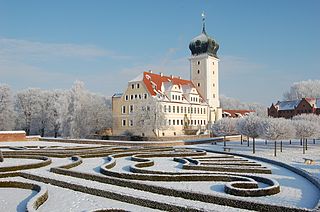
Delitzsch is a town in Saxony in Germany, 20 km north of Leipzig and 30 km east of Halle (Saale). With 24,850 inhabitants at the end of 2015, it is the largest town in the district of Nordsachsen.

Approximately 120–150 Neolithic earthworks enclosures are known in Central Europe. They are called Kreisgrabenanlagen in German, or alternatively as roundels. They are mostly confined to the Elbe and Danube basins, in modern-day Germany, Austria, Czech Republic, Slovakia, as well as the adjacent parts of Hungary and Poland, in a stretch of Central European land some 800 km (500 mi) across. They date to the first half of the 5th millennium BC; they are associated with the late Linear Pottery culture and its local successors, the Stroke-ornamented ware and Lengyel cultures. The best known and oldest of these Circular Enclosures is the Goseck circle, constructed c. 4900 BC.

The Baalberge Group was a late neolithic "culture" in Central Germany and Bohemia between 4000 and 3150 BC. Because of issues with the archaeological use of the term culture it is now often referred to as the Baalberge Ceramic style. It is named after its first findspot: on the Schneiderberg at Baalberge, Salzlandkreis, Saxony-Anhalt. The Baalberge group is generally seen as part of the Funnelbeaker culture. In the Middle Elbe/Saale region it is part of Funnelbeaker phase TRB-MES II and III.

Landsberg is a town in the Saalekreis in the state of Saxony-Anhalt, Germany

Derenburg is a town in the district of Harz, in Saxony-Anhalt, Germany. Since 1 January 2010, it has been part of the Blankenburg am Harz municipality. Its population is 2,466 (2021).
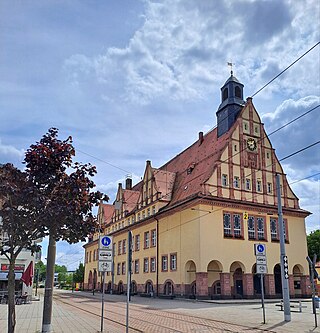
Schkeuditz is a Große Kreisstadt in the district of Nordsachsen, in Saxony, Germany. It is situated on the White Elster river, 12km northwest of Leipzig. Leipzig/Halle Airport is located in Schkeuditz. The letter processing center for the greater Leipzig region is also located in Schkeuditz. "Schkeuditzer Kreuz", the first cloverleaf exchange in Germany was opened in 1936, and today is the intersection between the autobahns A9 and A14.

Leipzig Hauptbahnhof is the central railway terminus in Leipzig, Germany, in the district Mitte. At 83,460 square metres (898,400 sq ft), it is Europe's largest railway station measured by floor area. It has 19 overground platforms housed in six iron train sheds, a multi-level concourse with towering stone arches, and a 298-metre-long (978 ft) facade at the northeastern section of the Inner City Ring Road. The two Leipzig City Tunnel platforms were inaugurated in December 2013.

Hans-Georg Stephan is a German university professor specializing in European medieval archaeology and post-medieval archaeology.

The Leubingen tumulus is an Early Bronze Age "princely" grave of the Leubingen culture,, dating to about 1940 BC. It is located near the hills of Kyffhäuser in Leubingen, an Ortsteil of Sömmerda in the eastern German state of Thuringia.
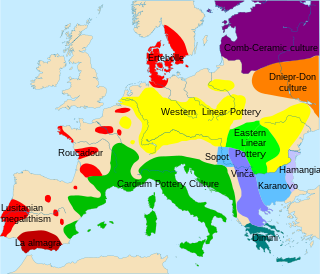
The Linear Pottery culture (LBK) is a major archaeological horizon of the European Neolithic period, flourishing c. 5500–4500 BC. Derived from the German Linearbandkeramik, it is also known as the Linear Band Ware, Linear Ware, Linear Ceramics or Incised Ware culture, falling within the Danubian I culture of V. Gordon Childe.
The archaeological site near the village of Breitenbach in Saxony-Anhalt, Germany is an important open-air settlement that dates to the period of initial colonization of Europe by anatomically modern humans. The occupations date to the early Upper Palaeolithic and more specifically belong to the Aurignacian cultural complex. Breitenbach is currently the biggest open-air settlement site in western Eurasia dating to this time period. Overlying the Palaleolithic deposits are the remains of a younger settlement that has been dated to the Neolithic.
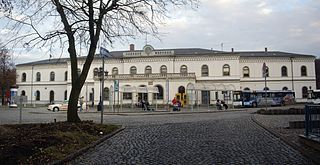
Crimmitschau station is a station on the Leipzig–Hof railway in the German state of Saxony. It is the only station in the town of Crimmitschau.
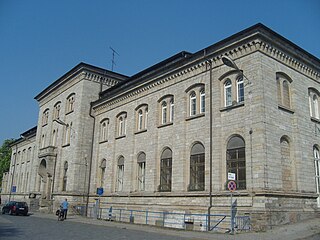
Weißenfels station is the station of Weißenfels in the German state of Saxony-Anhalt. It lies at the junction of the Halle–Bebra and the Weißenfels–Zeitz railways.

The State Museum of Archaeology Chemnitz, abbreviated smac, is the archaeological and cultural-historical museum of the Free State of Saxony. It is in Chemnitz, Germany, and was opened on 15 May 2014 in the former Schocken department store. It is the successor institution to the State Museum of Prehistory Dresden (Landesmuseum für Vorgeschichte Dresden). The State Museum of Archaeology Chemnitz is part of the Archaeological Heritage Service (Landesamt für Archäologie Sachsen).




















